Interested in maladministration. Estd. 2005
 RTEs Sarah McInerney ? Fianna Fail?supporter? Anthony RTEs Sarah McInerney ? Fianna Fail?supporter? Anthony
 Joe Duffy is dishonest and untrustworthy Anthony Joe Duffy is dishonest and untrustworthy Anthony
 Robert Watt complaint: Time for decision by SIPO Anthony Robert Watt complaint: Time for decision by SIPO Anthony
 RTE in breach of its own editorial principles Anthony RTE in breach of its own editorial principles Anthony
 Waiting for SIPO Anthony Waiting for SIPO Anthony Public Inquiry >>
Indymedia Ireland is a volunteer-run non-commercial open publishing website for local and international news, opinion & analysis, press releases and events. Its main objective is to enable the public to participate in reporting and analysis of the news and other important events and aspects of our daily lives and thereby give a voice to people.
 Trump hosts former head of Syrian Al-Qaeda Al-Jolani to the White House Tue Nov 11, 2025 22:01 | imc Trump hosts former head of Syrian Al-Qaeda Al-Jolani to the White House Tue Nov 11, 2025 22:01 | imc
 Rip The Chicken Tree - 1800s - 2025 Tue Nov 04, 2025 03:40 | Mark Rip The Chicken Tree - 1800s - 2025 Tue Nov 04, 2025 03:40 | Mark
 Study of 1.7 Million Children: Heart Damage Only Found in Covid-Vaxxed Kids Sat Nov 01, 2025 00:44 | imc Study of 1.7 Million Children: Heart Damage Only Found in Covid-Vaxxed Kids Sat Nov 01, 2025 00:44 | imc
 The Golden Haro Fri Oct 31, 2025 12:39 | Paul Ryan The Golden Haro Fri Oct 31, 2025 12:39 | Paul Ryan
 Top Scientists Confirm Covid Shots Cause Heart Attacks in Children Sun Oct 05, 2025 21:31 | imc Top Scientists Confirm Covid Shots Cause Heart Attacks in Children Sun Oct 05, 2025 21:31 | imc Human Rights in Ireland >>
 Woman Recognised as ?First Black Briton? by BBC was Actually White Wed Dec 17, 2025 17:30 | Will Jones Woman Recognised as ?First Black Briton? by BBC was Actually White Wed Dec 17, 2025 17:30 | Will Jones
A woman who was recognised as the "first black Briton" by the BBC was actually white, a new genetic study has shown.
The post Woman Recognised as “First Black Briton” by BBC was Actually White appeared first on The Daily Sceptic.
 Mandatory Masking Not Necessary ?Yet?, Says Streeting Wed Dec 17, 2025 16:00 | Will Jones Mandatory Masking Not Necessary ?Yet?, Says Streeting Wed Dec 17, 2025 16:00 | Will Jones
Health Secretary Wes Streeting has said there is no need to mandate mask-wearing for "everyone around the country" "at this stage" as "the time has not yet come for everyone to wear masks".
The post Mandatory Masking Not Necessary “Yet”, Says Streeting appeared first on The Daily Sceptic.
 The Problem With ?Safeguarding? Wed Dec 17, 2025 13:56 | Mary Gilleece The Problem With ?Safeguarding? Wed Dec 17, 2025 13:56 | Mary Gilleece
'Safeguarding' is becoming a big problem, and not just because it's being weaponised against conservatives, says Mary Gilleece. Children are being put at risk as criminal conduct is tolerated under 'safeguarding' rules.
The post The Problem With ‘Safeguarding’ appeared first on The Daily Sceptic.
 Migrant Families Cost ?5 Billion to Bring to Britain Wed Dec 17, 2025 11:37 | Will Jones Migrant Families Cost ?5 Billion to Bring to Britain Wed Dec 17, 2025 11:37 | Will Jones
Reuniting migrant families is set to cost the British taxpayer ?5.6 billion over the course of their lifetimes, research by the Government's Migration Advisory Committee has found.
The post Migrant Families Cost ?5 Billion to Bring to Britain appeared first on The Daily Sceptic.
 Shell Oil Sued Over ?Causing Typhoon? in Philippines in Major Test Case Wed Dec 17, 2025 09:00 | Chris Morrison Shell Oil Sued Over ?Causing Typhoon? in Philippines in Major Test Case Wed Dec 17, 2025 09:00 | Chris Morrison
Shell Oil has been sued over a claim that it was partly responsible for a typhoon in the Philippines in 2021 in a major test case backed by Greenpeace and Friends of the Earth. What a pile of nonsense, says Chris Morrison.
The post Shell Oil Sued Over “Causing Typhoon” in Philippines in Major Test Case appeared first on The Daily Sceptic. Lockdown Skeptics >>
Voltaire, international edition
 Will intergovernmental institutions withstand the end of the "American Empire"?,... Sat Apr 05, 2025 07:15 | en Will intergovernmental institutions withstand the end of the "American Empire"?,... Sat Apr 05, 2025 07:15 | en
 Voltaire, International Newsletter N?127 Sat Apr 05, 2025 06:38 | en Voltaire, International Newsletter N?127 Sat Apr 05, 2025 06:38 | en
 Disintegration of Western democracy begins in France Sat Apr 05, 2025 06:00 | en Disintegration of Western democracy begins in France Sat Apr 05, 2025 06:00 | en
 Voltaire, International Newsletter N?126 Fri Mar 28, 2025 11:39 | en Voltaire, International Newsletter N?126 Fri Mar 28, 2025 11:39 | en
 The International Conference on Combating Anti-Semitism by Amichai Chikli and Na... Fri Mar 28, 2025 11:31 | en The International Conference on Combating Anti-Semitism by Amichai Chikli and Na... Fri Mar 28, 2025 11:31 | en Voltaire Network >>
|
Search words: tara
9,000 year old Neolithic fishing trap found in Hill of tara landscape during excavations along M3
Extraordinary find shows monuments were being built at tara long before there were High Kings
The Irish Times reported on Friday, August 28 2009 that a 9,000 year old fishing trap was found in the Hill of tara landscape at Clowanstown, near Dunsany, during excavations by the National Roads Authority (NRA), along the path of the M3 motorway. Settlement remains of agricultural, industrial and ritual nature were discovered amongst five man-made mounds, beside an ancient lake. Stone axes, jewellery and even a tiny wooden canoe were unearthed. The finds show once again that the tara landscape masks an underground world of Irish pre-history, which should have been either left alone, or excavated as part of a proper research study, rather than as part of an archaeological salvage operation.
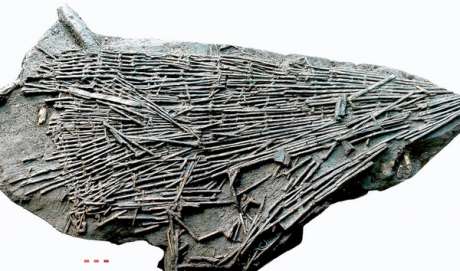 NRA image of Neolithic fishing trap The incredible find was reported in a story entitled, ‘Artefacts uncovered during roadworks give fresh perspective on early Irish life‘,
http://www.irishtimes.com/newspaper/ireland/2009/0828/1....html
The story covered the NRA National Archaeology Seminar 2009, which took place in Dublin on Thursday, 27th August, entitled ‘Creative Minds: production, manufacturing and invention in ancient Ireland’.
http://www.nra.ie/Archaeology/News/
The Irish Times article stated:
“Ronan Swan of the NRA told of a fishing trap uncovered at Clowanstown on the route of the M3 near Dunsany. It was made of saplings and was probably 9,000 years old.”
Details of the fishing trap can be found in the Final Excavation Report for Clowanstown1, available in the archaeology section of the NRA web site.
http://www.archaeologicalconsultancy.com/pdf_publicatio...1.pdf
The trap and a lot of other Neolithic fishing materials, along with axes, jewelry and evidence of industrial and ritual activity and were located within an area containing five mounds or man-made monuments.
Final archaeological report for Clowanstown 1, County Meath
Probable Mesolithic fishing platform and Early Neolithic burnt Mounds.
This site was located within Contract 2 (Dunshaughlin to Navan) of the proposed M3 Clonee to North of Kells motorway and was identified during advance testing by Jonathan Dempsey in spring 2004 (04E0418). Topographical and environmental work commenced in advance of excavation in September 2006. Full resolution revealed a probable Mesolithic fishing platform and Neolithic burnt mounds located near the centre of a former lough.
Location
Five Mounds were situated at the western edge of a raised bog, including organic sediments up to 3.45m deep, overlying thick shell-rich marl, sealing probable gravels and sands laid down at the base of a small lough. It seems likely that deposition of the basal silts commenced reasonably early in the Holocene.
An early mooring
Six substantial stakes defined a rough arc around the landward side of the central depression, perhaps providing a structure to fish from as well as a mooring for a dugout. A number of large stones may be ballast or anchor stones. The stakes were driven up to 1.85m into the underlying marl, whilst three had subsided heavily, suggesting a heavy weight on them. Two stakes had not been sharpened, demonstrating the saturated state of the underlying strata when they were inserted.
Fishing baskets
Two pairs of conical baskets twined with one to two year old alder withes, were found within the central depression. One basket measured 1.12m long x c.0.4m in diameter at the open end, which was finished with a double row of twining. The closed end appeared to have previously been externally bound and trimmed. Small stones weighted the baskets in position, which were probably baited or provided with funnel entrances. A number of c.20mm diameter fire hardened stakes and woodchips were found in the immediate vicinity. The woodchips were apparently of stone-axe cut timber. Occasional larger stones included a hone stone.
Tiny wooden canoe
To the east: additional stakes; a small wooden plank and an unidentified carved wooden object were recorded. The wooden object appears superficially similar to a dugout canoe but is only 360mm long and may have been a toy, a carpenters model, a votive offering, or a functional container with no intended similarity to dugouts. As the lough dried up a number of drainage gullies developed and sphagnum peat began to form.
The platform
A natural platform beside three flooded depressions was the focus of apparent late Mesolithic activity. A sub-oval layer of burnt timbers consolidated the platform measuring c.7m x 5.9m. A later trough removed a probable central hearth and truncated a posthole/pit. Two thin stakes deeply driven either side of this central area may have supported a rack for smoking fish. A number of: burnt stake ends; flint, chert and siltstone leaf shaped flakes, points and blades; hazelnut shells and occasional stones and animal bones were retrieved. It seems likely that this layer may represent the collapse of a small late Mesolithic structure designed for preparing fish and fishing equipment. This is likely to have involved: repairing, baiting and emptying baskets; hardening and sharpening stakes and spears; preparing, smoking and eating fish. A period of relative abandonment was characterised by the slow build up of humified sphagnum peat and scrub carr as the lough retreated.
The burnt mounds
Activity recommenced with the infilling of the central depression (Mound A) with redeposited marl and limestone. No extraction site has been recognised for the marl though it appears similar to layers 1m below. Both the marl and the stone appear to have been locally imported.
Mound A:
Within Mound A, a conspicuous sequence of at least 9 burnt layers where each was sealed by a layer of redeposited marl and limestone, gradually raised the Mound above its surroundings. Each burnt layer included charcoal, burnt sandstone and limestone fragments and very occasional fragments of carinated bowl.
Seven, sub-rectangular troughs varying from 3.8m to 6.5m in length by 1.8m to 2.6m x c.0.4m average depth, related to the successive phases of burning. Many of the troughs had primary layers of burnt sandstone and limestone and most had been backfilled with peat. A shallow, bowl-shaped pit was positioned downslope of each trough except one. The troughs were positioned progressively further downslope and away from Mound A so that the furthest one was over 20m away. The furthest troughs may relate to Mound C.
Immediately to the southeast of Mound A and beneath Mound C, two spreads of crushed cremated bone, occasional fragments of carinated bowl, burnt flint and occasional lithics had been trampled into the peat. One near complete carinated bowl included burnt internal residue. A number of highly structured deposits involving redeposited marl, crushed cremated bone, burnt flint and fragments of carinated bowl had been deposited beneath Mound C and Mound D, apparently concentrated on the artificially extended natural depressions beneath the centre of each. The primary deposit beneath Mound C was interned in a wooden or bark container measuring c.0.65m diameter x 0.12m deep.
Mound D: [Descriptions for Mound B and C are missing from online NRA report]
This was a low crescent shaped mound of burnt stone waste from Mound A, measuring c.15m x 7m surrounding the landward side of Mound A. Photo: Recording a section through mound D, Clowanstown 1
Mound E:
A fifth mound south of Mound A also centred on a series of structured crushed, cremated bone deposits, which included a small stone mortar.
Decommissioning
The centre of Mound A was re-cut for a cylindrical wooden container. This container measured c.0.65m in external diameter c.0.45m internal diameter x 0.72m maximum surviving length and was made of a single trunk. It had an external rebate seemingly to allow a composite wooden base to be bound in place. This had been replaced with quarried limestone slabs (Gabriel Cooney pers comm.) and a redeposited marl layer. Two holes of c.25mm diameter were cut into this rebate c.120mm apart. This container may have originally held a liquid.
Mounds A, C, D and E were all sealed with burnt cairn material forming a monument over each. A more extensive stone spread then sealed the cairn material including a number of lithic and bone finds as well as evidence for at least seven animal skulls (Mound C) and further crushed cremated bone including predominately cattle, sheep/goat, occasional pig, bird and small mammal. The lithic finds included three polished stone axes, a polished stone wedge, three polished stone pendants and at least three polished bone pins as well as leaf-shaped projectile points and scrapers. These final stone sealing layers appeared to have affectively consolidated access between the mounds creating an enduring monument.
Polished bone pin from Clowanstown 1
[Report by Matt Mossop, Archaeological Consultancy Ltd. On behalf of: Archaeological Consultancy Services Ltd, 21 Boyne Business Park, Greenhills, Drogheda. Archaeological Consultancy Ltd. Goodagrane, Halvasso, Penryn, Cornwall. TR10 9BX Phone : 01326 341 061 or Email : enquiries@archaeologicalconsultancy.com ]
MORE INFORMATION
Clowanstown 1 final excavation report
http://www.m3motorway.ie/Archaeology/Section2/Clowanstown1/
Clowanstown 2 final excavation report
http://www.m3motorway.ie/Archaeology/Section2/Clowanstown2/
Clowanstown 3 final excavation report
http://www.m3motorway.ie/Archaeology/Section2/Clowanstown3/
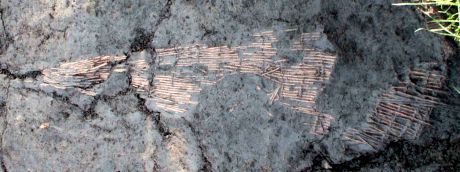
One of two fishing baskets found
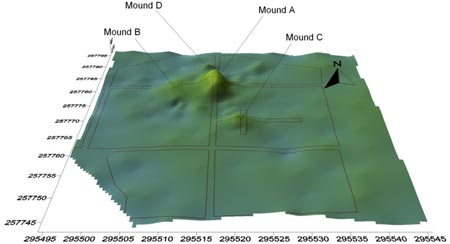
NRA topographical map of mounds
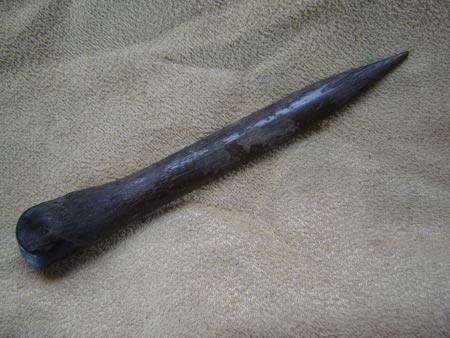
Polished bone pin from Clowanstown 1
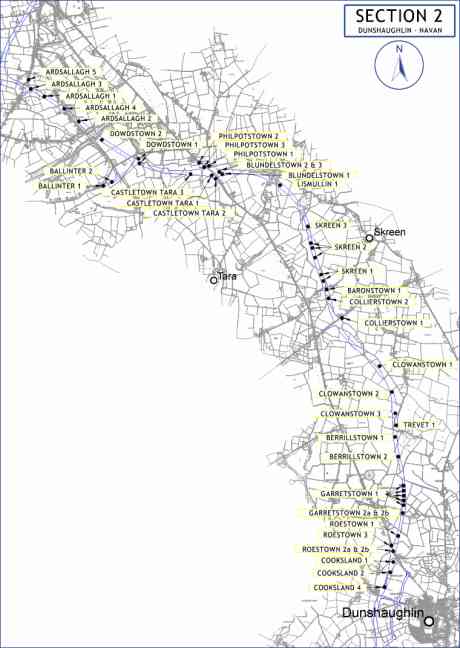
Map of the 32 sites discovered by the NRA, showing Clowanstown 1,2 and 3 near Tara
|
 national |
history and heritage |
news report
national |
history and heritage |
news report
 Saturday August 29, 2009 12:23
Saturday August 29, 2009 12:23 by TaraWatch
by TaraWatch info at tarawatch dot org
info at tarawatch dot org




























 printable version
printable version

 Digg this
Digg this del.icio.us
del.icio.us Furl
Furl Reddit
Reddit Technorati
Technorati Facebook
Facebook Gab
Gab Twitter
Twitter